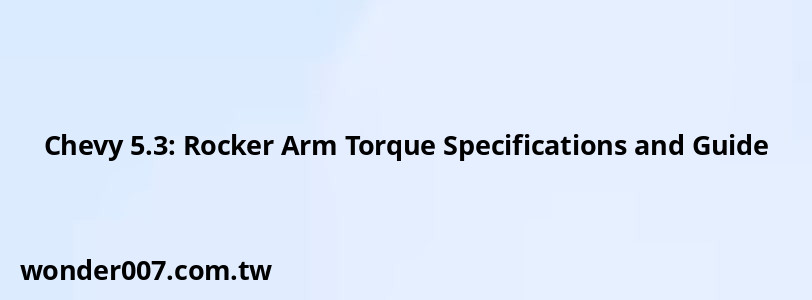Chevy 5.3: Rocker Arm Torque Specifications and Guide

The Chevy 5.3 engine, part of the LS series, is popular among automotive enthusiasts and mechanics alike. Understanding the rocker arm torque specifications is crucial for ensuring optimal engine performance and longevity. This guide provides detailed information on the torque specs, tightening sequence, and installation procedures for the rocker arms in the Chevy 5.3 engine.
Torque Specifications
The standard torque specification for the rocker arm bolts in the Chevy 5.3 engine is:
- Torque: 22 lb-ft (30 N·m)
This specification is critical to prevent damage to the engine components, especially when working with aluminum cylinder heads.
Rocker Arm Tightening Sequence
To properly tighten the rocker arms, follow these steps:
1. Position Cylinder One: Rotate the crankshaft until cylinder number one is at top dead center (TDC) on its compression stroke. At this point, the crankshaft sprocket key should be at the 1:30 position.
2. Tighten Rocker Arms:
- Tighten the intake valve rocker arm bolts for cylinders 1, 3, 4, and 5 to 22 lb-ft.
- Tighten the exhaust valve rocker arm bolts for cylinders 1, 2, 7, and 8 to 22 lb-ft.
3. Rotate Crankshaft: Rotate the crankshaft another 360 degrees to bring cylinder number one back to TDC.
4. Tighten Remaining Rockers:
- Tighten the intake valve rocker arm bolts for cylinders 2, 6, 7, and 8 to 22 lb-ft.
- Tighten the exhaust valve rocker arm bolts for cylinders 3, 4, 5, and 6 to 22 lb-ft.
Following this sequence ensures even pressure across all rocker arms and prevents potential damage from uneven torque.
Important Installation Tips
- Always use a calibrated torque wrench to achieve accurate torque settings.
- It is essential to ensure that each rocker arm is positioned correctly on its respective valve before tightening.
- If using aftermarket rocker arms or bolts, refer to their specific installation instructions as they may differ from OEM specifications.
FAQs About Chevy 5.3 Rocker Arm Torque Specs
- What happens if I over-torque the rocker arms?
Over-torquing can strip threads in aluminum heads or break bolts, leading to costly repairs. - Can I reuse rocker arm bolts?
Yes, but ensure they are not torque-to-yield (TTY) bolts as those should not be reused. - What is TDC?
Top Dead Center (TDC) is when the piston is at its highest point in the cylinder during its compression stroke.
Following these guidelines will help ensure that your Chevy 5.3 engine operates smoothly and efficiently while minimizing the risk of mechanical failure related to improper installation of rocker arms.
Related Posts
-
5.3 Vortec Coolant Capacity: Essential Guide
28-01-2025 • 173 views -
2016 Chevy Traverse: Power Steering Fluid Essentials
29-01-2025 • 202 views -
2008 Honda Accord Rear Brake Pads: Replacement Guide
30-01-2025 • 161 views -
1997 Dodge Caravan Speedometer Troubleshooting Guide
26-01-2025 • 176 views -
99 Jeep Cherokee Oil Pan Removal Guide
29-01-2025 • 175 views
Latest Posts
-
2015 Chevy Traverse AC Recharge Port Location
01-02-2025 • 409 views -
Power Steering Fluid Leak On Passenger Side
01-02-2025 • 457 views -
Are O2 Sensors Covered Under Warranty
01-02-2025 • 376 views -
Rear Brake Caliper Piston Won't Compress
01-02-2025 • 356 views -
How To Turn Off Paddle Shifters Mercedes
01-02-2025 • 377 views
Popular Posts
-
Hino Warning Lights: Understanding Dashboard Alerts
26-01-2025 • 765 views -
EPC Light: Understanding Causes and Solutions
26-01-2025 • 1053 views -
EPC Warning Light: What It Means for Your Vehicle
27-01-2025 • 630 views -
Power Steering and ABS Light On: Causes and Solutions
27-01-2025 • 643 views -
V12 Engine Costs: What You Need to Know
26-01-2025 • 679 views
